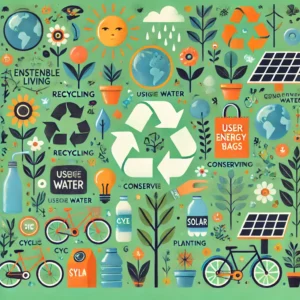In an era where environmental awareness is at an all-time high, taking steps toward sustainable living is more important than ever. Whether you’re an eco-warrior or just getting started, making small changes in your daily life can have a big impact on our planet. Ready to embrace a greener lifestyle? Here are 10 simple steps to help you on your journey toward sustainable living.
1. Reduce, Reuse, Recycle: The Three Rs
Let’s start with the basics: reducing, reusing, and recycling. These three Rs are foundational to sustainable living. Reducing means cutting down on waste by buying only what you need. Reusing involves finding new purposes for items rather than tossing them. Recycling is about processing materials so they can be used again. By incorporating these practices into your routine, you’re not only minimizing waste but also conserving resources.
2. Switch to Energy-Efficient Appliances
When it comes to saving energy and reducing your carbon footprint, energy-efficient appliances are a game-changer. Look for products with the ENERGY STAR label, which indicates they meet high energy efficiency standards. These appliances use less power and can save you money on your utility bills. From refrigerators to washing machines, making the switch is a smart move for both your wallet and the planet.
3. Embrace Sustainable Transportation
Transportation is a significant contributor to greenhouse gas emissions. One way to lessen your impact is by using public transport, carpooling, or biking instead of driving solo. If you’re in the market for a new car, consider an electric or hybrid vehicle. These options produce fewer emissions and are more environmentally friendly. Even small changes, like walking for short trips, can add up to a big difference.
4. Opt for Eco-Friendly Products
Choosing eco-friendly products is another essential step toward sustainable living. Look for items made from recycled materials, biodegradable products, or those that have minimal packaging. For example, bamboo toothbrushes and reusable shopping bags are great alternatives to their less sustainable counterparts. By making thoughtful purchases, you’re supporting companies that prioritize environmental responsibility.
5. Conserve Water
Water is a precious resource, and conserving it should be a top priority. Simple actions, like fixing leaks, installing low-flow showerheads, and turning off the tap while brushing your teeth, can significantly reduce your water usage. Additionally, collecting rainwater for gardening can help you save on water bills and keep your plants healthy.
6. Adopt a Plant-Based Diet

Adopting a plant-based diet can greatly reduce your environmental footprint. The production of meat and dairy products has a high environmental cost, including greenhouse gas emissions and deforestation. By incorporating more fruits, vegetables, and plant-based proteins into your meals, you’re not only improving your health but also contributing to a more sustainable food system.
7. Support Local and Organic Farming
Supporting local and organic farming helps reduce the carbon footprint associated with transporting food over long distances. Organic farming practices are also better for the environment, as they avoid synthetic pesticides and fertilizers. Shopping at farmers’ markets or joining a local CSA (Community Supported Agriculture) program ensures you’re getting fresh, sustainable produce while supporting local farmers.
8. Practice Energy Conservation at Home
Energy conservation isn’t just about the appliances you use; it’s also about how you manage energy in your home. Simple habits, like turning off lights when you leave a room, unplugging electronics when they’re not in use, and using programmable thermostats, can help you save energy. These small changes add up and contribute to a greener lifestyle.
9. Reduce Single-Use Plastics
Single-use plastics are a major environmental issue, contributing to pollution and wildlife harm. To combat this, try to reduce your reliance on single-use plastics like bags, bottles, and utensils. Opt for reusable alternatives such as stainless steel water bottles, cloth shopping bags, and glass containers. Every plastic item you avoid makes a difference.
10. Get Involved in Your Community
Finally, getting involved in your community can amplify your efforts toward sustainable living. Participate in local environmental groups, support clean-up initiatives, and spread awareness about sustainability practices. By working together, we can drive larger-scale changes and create a more eco-conscious community.
Conclusion
Living sustainably is about making conscious choices that benefit both you and the environment. By implementing these 10 simple steps, you can significantly reduce your carbon footprint and contribute to a greener future. Remember, every small action counts, and collectively, we can make a big difference.
FAQs
1. How can I start reducing waste at home?
Begin by assessing your current waste habits. Implement the three Rs—reduce, reuse, and recycle. Start with small changes, like using reusable bags and bottles, and gradually incorporate more sustainable practices.
2. Are energy-efficient appliances worth the investment?
Yes, energy-efficient appliances often save you money in the long run through lower utility bills and reduced energy consumption. They also contribute to a lower environmental impact.
3. What are some easy ways to conserve water?
Fix leaks, install water-saving fixtures, take shorter showers, and use rainwater for gardening. Every small effort helps in conserving this vital resource.
4. How can I make my diet more sustainable?
Incorporate more plant-based foods into your meals and reduce meat and dairy consumption. Consider buying locally grown and organic produce to further reduce your environmental impact.
5. How can I reduce my use of single-use plastics?
Opt for reusable items like water bottles, shopping bags, and containers. Avoid products with excessive plastic packaging and choose alternatives made from sustainable materials.